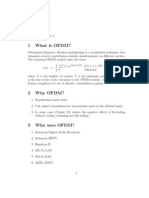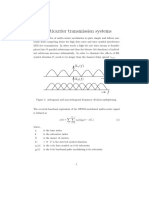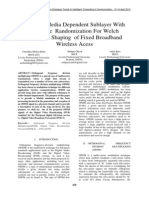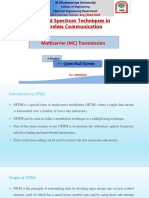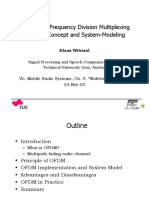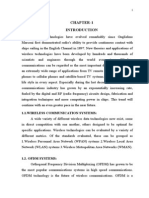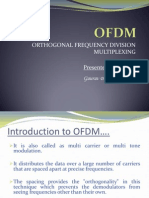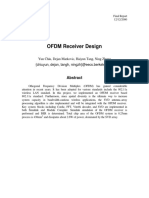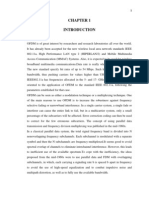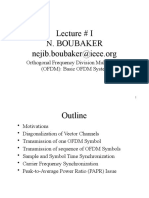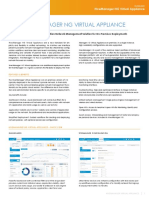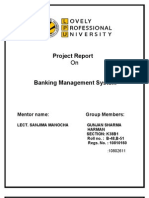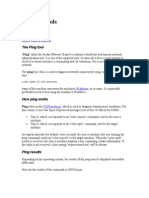Orthogonal Frequency
Division Multiplexing
OFDM
fred harris
Cubic Signal Processing Chair
San Diego State University
fred.harris@sdsu.edu
Vehicular Technology Conference - 2004
Textbooks and References
Wireless OFDM Systems: How to Make Them Work
Marc Engels, Editor
OFDM Wireless LANs: A Theoretical and Practical Guide
Juha Heiskala and John Terry
OFDM for Wireless Multimedia Communications
Richard Van Nee and Ramjee Prasad
Single and Multi-Carrier Quadrature Amplitude Modulation
Lajos Hanzo, William Webb, and Thomas Keller
ADSL, VDSL, and Multicarrier Modulation
John Bingham
Implementing ADSL
David Ginsburg
DSL Advances
Massimo Sorbara, John Cioffi, and Peter Silverman
OFDM
OFDM also known as
Multi-Carrier or Multi-Tone Modulation
DAB-OFDM
Digital Audio Broadcasting
DVD-OFDM
Digital Video Broadcasting
ADSL-OFDM
Asynchronous Digital Subscriber Line
Wireless Local Area Network
IEEE-802.11a, IEEE-802.11g
ETSI BRAN (Hyperlan/2)
OFDM Systems
System Transform
Size
Number
Carriers
Channel
Spacing
kHz
Bandwidth
MHz
Sample
Rate
MHz
Symbol
Duration
sec
Data
Rate
Mbits/s
HyperLAN/2 64 52
4
312.5 16.25 20 3.2
0.8
6-54
802.11a 64 52
4
312.5 16.56 20 3.2
0.8
6-54
DVB-T 2048
1024
1712
842
4.464 7.643 9.174 224 0.68-14.92
DAB 2048
8192
1536 1.00 1.536 2.048 24/48/96
msec
3.072
ADSL 256 (down)
64 (up)
36-127
7-28
4.3125 1.104 1.104 231.9 0.64-8.192
OFDM Advantages
Efficiently Deals With Multi-path Fading
Efficiently Deals With Channel Delay Spread
Enhanced Channel Capacity
Adaptively Modifies Modulation Density
Robustness to Narrowband Interference
OFDM Disadvantages
OFDM Sensitive to
Small Carrier Frequency Offsets
OFDM Exhibits
High Peak to Average Power Ratio
OFDM Sensitive to
High Frequency Phase Noise
OFDM Sensitive to
Sampling Clock Offsets
Single Carrier System
Sequential Transmission
of Waveforms
Waveforms are
Short Duration T
Waveforms Occupy
Full System Bandwidth 1/T
Multi-Carrier System
Parallel Transmission
of Waveforms
Waveforms are
Long Duration MT
Waveforms Occupy 1/M th
Of System Bandwidth 1/T
OFDM: Dense Multichannel System
Conventional Multichannel System
Non Overlapping Adjacent Channels.
Channels separated by More
Than Their Two Sided bandwidth
OFDM Multichannel System
50% Overlap of Adjacent Channels
Available bandwidth is Used Twice
Channels separated by Half
Their Two Sided bandwidth
Standard Digital
Communication System
Bandlimited Channel
Nyquist Spectrum
Nyquist Spectrum
With Cosine Taper
Infinite Duration Nyquist Pulse Finite Duration Nyquist Pulse
Translation in Time Domain
Phase Slope in Frequency Domain
Translated Signals Are Orthogonal When Peak is Translated to Zero Crossings of Original
Channel Distortion
Modifies Received Wave Shape
-6 -4 -2 0 2 4 6
-0.2
0
0.2
0.4
0.6
0.8
1
Matched Filter Output For SQRT Nyquist Pulse
-6 -4 -2 0 2 4 6
-0.2
0
0.2
0.4
0.6
0.8
1
Matched Filter Output For Channel Distorted SQRT Nyquist Pulse
Inter Symbol Interference (ISI)
Due to Channel Distorted Signal
-1 -0.8 -0.6 -0.4 -0.2 0 0.2 0.4 0.6 0.8 1
-2
-1
0
1
2
Eye Diagram No Channel Distortion
-1 -0.8 -0.6 -0.4 -0.2 0 0.2 0.4 0.6 0.8 1
-2
-1
0
1
2
Eye Diagram With Channel Distortion
Steady State Response of a Filter
to a Sine Wave is a Sine Wave
Rectangle Pulse: DC Centered Spectrum
with Equally Spaced Zeros
0
sin(2 )
2
( )
(2 )
2
P
P
P
T
f
H f AT
T
f
t
t
=
Shift Spectrum with Linear Phase on DC
Pulse: Move Spectrum to First Spectral Zero
)
2
)
1
( 2 (
)
2
)
1
( 2 sin(
) (
P
p
P
p
P k
T
T
k f
T
T
k f
AT f H
=
t
t
Real Part of Complex Exponential Time Series:
Integer Number of Cycles per Interval
0 0.5 1
-1
0
1
0 0.5 1
-1
0
1
0 0.5 1
-1
0
1
0 0.5 1
-1
0
1
0 0.5 1
-1
0
1
0 0.5 1
-1
0
1
0 0.5 1
-1
0
1
0 0.5 1
-1
0
1
0 0.5 1
-1
0
1
0 0.5 1
-1
0
1
0 0.5 1
-1
0
1
0 0.5 1
-1
0
1
0 0.5 1
-1
0
1
0 0.5 1
-1
0
1
0 0.5 1
-1
0
1
0 0.5 1
-1
0
1
Imaginary Part of Complex Exponential Time Series:
Integer Number of Cycles per Interval
0 0.5 1
-1
0
1
0 0.5 1
-1
0
1
0 0.5 1
-1
0
1
0 0.5 1
-1
0
1
0 0.5 1
-1
0
1
0 0.5 1
-1
0
1
0 0.5 1
-1
0
1
0 0.5 1
-1
0
1
0 0.5 1
-1
0
1
0 0.5 1
-1
0
1
0 0.5 1
-1
0
1
0 0.5 1
-1
0
1
0 0.5 1
-1
0
1
0 0.5 1
-1
0
1
0 0.5 1
-1
0
1
0 0.5 1
-1
0
1
Spectra Of Complex Exponential Time Series:
Integer Number of Cycles per Interval
0 0.5
0
0.5
1
0 0.5
0
0.5
1
0 0.5
0
0.5
1
0 0.5
0
0.5
1
0 0.5
0
0.5
1
0 0.5
0
0.5
1
0 0.5
0
0.5
1
0 0.5
0
0.5
1
0 0.5
0
0.5
1
0 0.5
0
0.5
1
0 0.5
0
0.5
1
0 0.5
0
0.5
1
0 0.5
0
0.5
1
0 0.5
0
0.5
1
0 0.5
0
0.5
1
0 0.5
0
0.5
1
Continuous Time: Orthogonal Time Signal Set
}
=
=
=
< s
=
=
< s
=
-
T
m n
k
m n if T
m n if
dt t t
T t
k
t k
T
j t
T t
k
t
0
k
0
) ( ) (
0
, , 2 , 1 , 0 , 1 , 2 ,
: )
2
exp( ) (
0
, , 2 , 1 , 0 , 1 , 2 ,
: ) (
t
Discrete Time: Orthogonal Time Signal Set
k
1
0
..., 2, 1, 0 , 1, 2, ....,
( ) :
0 1
0 , 1, 2, ...., 1
2
( ) exp( ) :
0
0 , 1, 2, ...., 1
2
exp( ) :
0
0
( ) ( )
: ( ) ( ) ( ) ( )
k
N
n m
n
k N k k N k
k
n
n N
k N
n j k nT
NT nT NT
k N
j k n
N n N
if n m
n n
N if n m
NOTE n n n n
-
=
+
=
s s
=
=
s <
=
=
s <
=
=
=
= =
OFDM Modulator
OFDM Demodulator
OFDM is a Block Process
Adjacent Symbol Interference (ASI)
Symbol Smearing Due to Channel
Guard Interval Inserted Between Adjacent
Symbols to Suppress ASI
Cyclic Prefix Inserted in Guard Interval to
Suppress Adjacent Channel Interference (ACI)
Data Length Defines Sinc Width:
Spectral Spacing Matches Width
Extended Data Length Reduces Sinc
Width: Spectral Spacing Preserved
OFDM Symbol: Time and Spectra
Channel Input and Output
20 40 60 80 100 120 140 160 180
-0.4
-0.2
0
0.2
0.4
0.6
Real Part of Time Series, Input to Channel
20 40 60 80 100 120 140 160 180
-0.4
-0.2
0
0.2
0.4
0.6
Real Part of Time Series, Output of Channel
-0.5 0 0.5
-30
-25
-20
-15
-10
-5
0
5
10
Spectrum
-0.5 0 0.5
-30
-25
-20
-15
-10
-5
0
5
10
Spectrum
OFDM Spectra
Without and with Cyclic Prefix
-0.5 -0.4 -0.3 -0.2 -0.1 0 0.1 0.2 0.3 0.4 0.5
-1.5
-1
-0.5
0
0.5
1
1.5
OFDM spectral lines With Channel Without Cyclic Prefix
-0.5 -0.4 -0.3 -0.2 -0.1 0 0.1 0.2 0.3 0.4 0.5
-1.5
-1
-0.5
0
0.5
1
1.5
OFDM spectral lines With Channel With Cyclic Prefix
Overlaid Constellations , All Frequencies,
Without and With Cyclic Prefix
-1.5 -1 -0.5 0 0.5 1 1.5
-1.5
-1
-0.5
0
0.5
1
1.5
OFDM Constellations With Channel Without Cyclic Prefix
-1.5 -1 -0.5 0 0.5 1 1.5
-1.5
-1
-0.5
0
0.5
1
1.5
OFDM Constellations With Channel With Cyclic Prefix
Constellations: Different OFDM Bins
Without Cyclic Prefix
-1 0 1
-1
0
1
-1 0 1
-1
0
1
-1 0 1
-1
0
1
-1 0 1
-1
0
1
-1 0 1
-1
0
1
-1 0 1
-1
0
1
Constellations: Different OFDM Bins
With Cyclic Prefix
-1 0 1
-1
0
1
-1 0 1
-1
0
1
-1 0 1
-1
0
1
-1 0 1
-1
0
1
-1 0 1
-1
0
1
-1 0 1
-1
0
1
Channel Estimate with Pilots
-1 -0.8 -0.6 -0.4 -0.2 0 0.2 0.4 0.6 0.8 1
0
0.5
1
Channel, Bandwidth, and Samples
-1 -0.8 -0.6 -0.4 -0.2 0 0.2 0.4 0.6 0.8 1
0
0.5
1
Zero Packed
Spectral Samples
and
Extended Reflection
-1 -0.8 -0.6 -0.4 -0.2 0 0.2 0.4 0.6 0.8 1
0
0.5
1
Interpolated
Spectral Points
-1 -0.8 -0.6 -0.4 -0.2 0 0.2 0.4 0.6 0.8 1
0
0.005
0.01
Magnitude of Interpolation Error For In-Band Frequencies
Normalized Frequency
DFT (FFT) as Signal Generator
for Complex Sinusoids
DFT (FFT) As Signal Analyzer
for Complex Sinusoids
1 , ... , 2 , 1 , 0 : ) ( ) (
1
0
2
= =
N k e n h k H
N
n
nk
N
j
t
Radix-2 FFT Flow Diagrams
Input Vector FFT Mapped to Output Time Series,
Up-Sampled, Converted Via DAC to Waveform,
and I-Q Up-Converted
The FFT as Signal Generator
and Interpolator
OFDM Modulation With IFFT
and Interpolator
OFDM Demodulation With FFT
OFDM Transceiver
Time and Spectra of Sparse OFDM Symbol
0 10 20 30 40 50 60 70 80 90 100
-1
-0.5
0
0.5
1
Real Part OFDM Time Series
Normalized Time
A
m
p
l
i
t
u
d
e
-0.5 -0.4 -0.3 -0.2 -0.1 0 0.1 0.2 0.3 0.4 0.5
-60
-50
-40
-30
-20
-10
0
10
Spectrum
Normalized Frequency
L
o
g
M
a
g
n
i
t
u
d
e
(
d
B
)
Time and Spectra With Frequency Offset = 0.1 Bin
0 10 20 30 40 50 60 70 80 90 100
-1
-0.5
0
0.5
1
Real Part OFDM Time Series with Offset Frequency = 0.1 Bin Width
Normalized Time
A
m
p
l
i
t
u
d
e
-0.5 -0.4 -0.3 -0.2 -0.1 0 0.1 0.2 0.3 0.4 0.5
-60
-50
-40
-30
-20
-10
0
10
Spectrum With Frequency Offset = 0.1 Bin Width
Normalized Frequency
L
o
g
M
a
g
n
i
t
u
d
e
(
d
B
)
Time and Spectra With Sample Clock Offset = 1.02 f
s
0 10 20 30 40 50 60 70 80 90 100
-1
-0.5
0
0.5
1
Real Part OFDM Time Series with Sampling Clock = 1.02 f
s
Normalized Time
A
m
p
l
i
t
u
d
e
-0.5 -0.4 -0.3 -0.2 -0.1 0 0.1 0.2 0.3 0.4 0.5
-60
-50
-40
-30
-20
-10
0
10
Spectrum With Sampling Clock = 1.02 f
s
Normalized Frequency
L
o
g
M
a
g
n
i
t
u
d
e
(
d
B
)
Time and Spectra With Sample Clock Offset = 0.98 f
s
0 10 20 30 40 50 60 70 80 90 100
-1
-0.5
0
0.5
1
Real Part OFDM Time Series with Sampling Clock = 0.98 f
s
Normalized Time
A
m
p
l
i
t
u
d
e
-0.5 -0.4 -0.3 -0.2 -0.1 0 0.1 0.2 0.3 0.4 0.5
-60
-50
-40
-30
-20
-10
0
10
Spectrum With Sampling Clock = 0.98 f
s
Normalized Frequency
L
o
g
M
a
g
n
i
t
u
d
e
(
d
B
)
Ideal I-Q Up and Down Conversion
Shape
Shape
Match
Match
CHANNEL
cos( t) e
0
cos( t) e
0
-sin( t) e
0
-sin( t) e
0
n(t)
I(t)
I(t)
Q(t)
Q(t)
^
^
Spectral and Time Description of
Real Sinusoids
Complex Sinusoids-I
Complex Sinusoids-II
Complex Baseband and Complex
Band-Centered Spectra
Complex Baseband and Real
Band-Centered Spectra
Complex Down Conversion
Gain and Phase Imbalance in
I-Q Mixers
Spectral Image Due to Gain Imbalance
Spectral Image Due to Phase Imbalance
Line Spectral Images Due to I-Q Mismatch
Coupling Between Positive and Negative FFT Indices Due to
I-Q Imbalance and First Order Correction Mechanism
(1 ) ( )
( ) ( )
2 2 2
( ) ( )
( ) (1 )
2 2 2
(1 ) ( )
( ) ( )
2 2 2
( ) ( )
( ) (1 )
2 2 2
j j
G k H k
G k H k
j j
j j
H k G k
H k G k
j j
o c o
c o o
o c o
c o o
(
(
( (
=
(
( (
(
(
(
+ + +
(
( (
~
(
( (
(
+ + +
(
Test Bench: Demonstration of Receiver I-Q
Imbalances, Carrier Offset, and Timing Offset
Carrier Offset: 4% of FFT Bin Width
Timing Offset: 10% of Sampling Time Period
Timing Clock Offset: 5% of Sampling Time Period per Frame
Gain Imbalance: 10% Error
Phase Imbalance: 0.1 Radian Error
I-Q Mixer Imbalance; 20% Gain, 0.2 Radians
Differential Delay to I/Q Mixers,
10% of Sample Interval
Periodic Time Segments in OFDM Frame
Obtained by Zero Packing Spectrum
Probe Mismatch During Short Repeated Preamble
Power Amplifier Non-Linearity
0 1 2 3 4
0
0.5
1
1.5
2
2.5
3
3.5
4
Nonlinear Transfer Function of Amplifier
1-dB Compression Point
0 2 4 6 8 10
-2
-1.5
-1
-0.5
0
0.5
1
1.5
2
Input and Output of Non-Linear Amplifier
-0.5 0 0.5
-60
-50
-40
-30
-20
-10
0
10
Spectrum of Two Input Sinusoids
Normalized Frequency
-0.5 0 0.5
-60
-50
-40
-30
-20
-10
0
10
Spectrum of Two Output Sinusoids
Normalized Frequency
16-QAM Input and Output Envelopes.
Saturation and 1-dB Compression Circles
-2 -1 0 1 2
-2
-1.5
-1
-0.5
0
0.5
1
1.5
2
Envelope at Output of Amplifier
-2 -1 0 1 2
-2
-1.5
-1
-0.5
0
0.5
1
1.5
2
Envelope at Input to Amplifier
Saturation at 2-Times RMS Signal Level
Saturation
Saturation
1-dB
Compression
1-dB
Compression
Limiting Amplifier Effect on Received QAM Constellation
-1 -0.5 0 0.5 1
-1
-0.8
-0.6
-0.4
-0.2
0
0.2
0.4
0.6
0.8
1
Matched Filter Applied to Input of Amplifier
-1 -0.5 0 0.5 1
-1
-0.8
-0.6
-0.4
-0.2
0
0.2
0.4
0.6
0.8
1
Matched Filter Applied to Output of Amplifier
Limiting Amplifier Effect on Signal Spectra
-4 -3 -2 -1 0 1 2 3 4
-60
-50
-40
-30
-20
-10
0
10
Spectrum at Input to Amplifier
Normalized Frequency (f/f
sym
)
L
o
g
M
a
g
n
i
t
u
d
e
(
d
B
)
-4 -3 -2 -1 0 1 2 3 4
-60
-50
-40
-30
-20
-10
0
10
Spectrum at Output of Amplifier
Normalized Frequency (f/f
sym
)
L
o
g
M
a
g
n
i
t
u
d
e
(
d
B
)
SPECTRAL REGROWTH
16-QAM (o=0.2) Envelope Statistics
0 0.5 1 1.5 2 2.5
0
0.002
0.004
0.006
0.008
0.01
0.012
0.014
0.016
16-QAM Histogram at Amplifier Input
Normalized Amplitude (x/o
x
)
0 0.5 1 1.5 2 2.5
0
0.002
0.004
0.006
0.008
0.01
0.012
0.014
0.016 std dev =1.03
clip level
16-QAM Histogram at Amplifier Output
Normalized Amplitude (x/o
x
)
0 0.5 1 1.5 2 2.5 3
10
-6
10
-5
10
-4
10
-3
10
-2
10
-1
10
0
Probabilty of Level Crossing
Normalized Amplitude (x/o
x
)
OFDM Input and Output Envelopes:
Saturation and 1-dB Compression Circles
-3 -2 -1 0 1 2 3
-3
-2
-1
0
1
2
3
Envelope at Input to Amplifier
-3 -2 -1 0 1 2 3
-3
-2
-1
0
1
2
3
Envelope at Output of Amplifier
Saturation at 2-Times RMS Signal Level
Saturation
Saturation
1-dB
Compression
1-dB
Compression
Limiting Amplifier Effect on OFDM Constellation
-1 -0.5 0 0.5 1
-1
-0.8
-0.6
-0.4
-0.2
0
0.2
0.4
0.6
0.8
1
OFDM Constellation at Input to Amplifier
-1 -0.5 0 0.5 1
-1
-0.8
-0.6
-0.4
-0.2
0
0.2
0.4
0.6
0.8
1
OFDM Constellation at Output of Amplifier
OFDM Envelope Statistics
0 1 2 3 4
0
0.005
0.01
0.015
OFDM Histogram at Amplifier Input
Normalized Amplitude (x/o
x
)
0 1 2 3 4
0
0.005
0.01
0.015
std dev =1.06 clip level
OFDM Histogram at Amplifier Output
Normalized Amplitude (x/o
x
)
0 1 2 3 4
10
-6
10
-5
10
-4
10
-3
10
-2
10
-1
10
0
Probabilty of Level Crossing
Normalized Amplitude (x/o
x
)
OFDM Envelope Statistics with
Selected Alternate Mapping
0 1 2 3 4
0
0.005
0.01
0.015
0.02
OFDM Histogram: One FFT
0 1 2 3 4
0
0.005
0.01
0.015
0.02
OFDM Histogram: Two FFTs
0 1 2 3 4
0
0.005
0.01
0.015
0.02
OFDM Histogram: Four FFTs
Normalized Amplitude (x/o
x
)
0 1 2 3 4
10
-6
10
-5
10
-4
10
-3
10
-2
10
-1
10
0
Probabilty of Level Crossing
Normalized Amplitude (x/o
x
)
One FFT Two FFTs
Four FFTs
Clipping
Smart Clipping
Reserve Frequency Bins Form Clipping
Pulses
Selecting Reserve Frequency Bins
-60 -40 -20 0 20 40 60
0
0.2
0.4
0.6
0.8
1
Spectrum 11-Adjacent Frequencies
-0.5 0 0.5
0
0.2
0.4
0.6
0.8
1
Time Series for 11-Adjacent Frequencies
-60 -40 -20 0 20 40 60
0
0.2
0.4
0.6
0.8
1
Spectrum 11-Equally Spaced Frequencies
-0.5 0 0.5
0
0.2
0.4
0.6
0.8
1
Time Series for 11-Equally Spaced Frequencies
-60 -40 -20 0 20 40 60
0
0.2
0.4
0.6
0.8
1
Spectrum 11-Randomly Spaced Frequencies
-0.5 0 0.5
0
0.2
0.4
0.6
0.8
1
Time Series for 11-Randomly Spaced Frequencies
Reserve Bin Canceller Clipping at 2.5 o (8 dB)
0 50 100 150 200 250
0
1
2
3
4
5
Peak envelope, input to PAR control
0 50 100 150 200 250
0
1
2
3
4
5
Peak envelope, output of first pass PAR control
data
clip level
data std dev
average peak
0 50 100 150 200 250
0
1
2
3
4
5
Peak envelope, output of second pass PAR control
data
clip level
data std dev
average peak
0 50 100 150 200 250
0
1
2
3
4
5
Peak envelope, output of third pass PAR control
data
clip level
data std dev
average peak
Statistics for Clip at 2.5 (8 dB)
0 1 2 3 4
0
0.005
0.01
0.015
0.02
0.025
input histogram
0 1 2 3 4
0
0.005
0.01
0.015
0.02
0.025
std dev =0.928
clip level
output histogram
-5 0 5 10
10
-6
10
-5
10
-4
10
-3
10
-2
10
-1
10
0
average =-0.648 dB
prob of level crossing
PAR (dB)
input
pass-1
pass-2
pass-3
Reserve Bin Canceller Clipping at 2.2 o (6.9 dB)
0 50 100 150 200 250
0
1
2
3
4
5
Peak envelope, input to PAR control
0 50 100 150 200 250
0
1
2
3
4
5
Peak envelope, output of first pass PAR control
data
clip level
data std dev
average peak
0 50 100 150 200 250
0
1
2
3
4
5
Peak envelope, output of second pass PAR control
data
clip level
data std dev
average peak
0 50 100 150 200 250
0
1
2
3
4
5
Peak envelope, output of third pass PAR control
data
clip level
data std dev
average peak
Statistics for Clip at 2.2 (6.9 dB)
0 1 2 3 4
0
0.005
0.01
0.015
0.02
0.025
input histogram
0 1 2 3 4
0
0.005
0.01
0.015
0.02
0.025
std dev =0.928
clip level
output histogram
-5 0 5 10
10
-6
10
-5
10
-4
10
-3
10
-2
10
-1
10
0
average =-0.653 dB
prob of level crossing
PAR (dB)
input
pass-1
pass-2
pass-3
Reserve Bin Canceller Clipping at 2.0 o (6 dB)
0 50 100 150 200 250
0
1
2
3
4
5
Peak envelope, input to PAR control
0 50 100 150 200 250
0
1
2
3
4
5
Peak envelope, output of first pass PAR control
data
clip level
data std dev
average peak
0 50 100 150 200 250
0
1
2
3
4
5
Peak envelope, output of second pass PAR control
data
clip level
data std dev
average peak
0 50 100 150 200 250
0
1
2
3
4
5
Peak envelope, output of third pass PAR control
data
clip level
data std dev
average peak
Statistics for Clip at 2.0 (6 dB)
0 1 2 3 4
0
0.005
0.01
0.015
0.02
0.025
input histogram
0 1 2 3 4
0
0.005
0.01
0.015
0.02
0.025
std dev =0.927
clip level
output histogram
-5 0 5 10
10
-6
10
-5
10
-4
10
-3
10
-2
10
-1
10
0
average =-0.659 dB
prob of level crossing
PAR (dB)
input
pass-1
pass-2
pass-3
OFDM 802.11a
Time-Frequency Profile of 802.11a Tones
Pilot Tones Shown in Yellow
Preamble and Pilot Structure
Short Symbols
Start of Frame Detection
Signal Strength Indication
Frequency Offset Resolution
Long Symbols
Channel Estimate
Fine Time Resolution
Distributed Pilots
Carrier Tracking
Sample Clock Tracking
Preamble Time Structure
0 0.5 1 1.5 2 2.5 3 3.5 4 4.5 5
0
0.2
0.4
0.6
0.8
Magnitude IEEE 802.11a Preamble
0 0.5 1 1.5 2 2.5 3 3.5 4 4.5 5
-1
-0.5
0
0.5
1
Real Part
0 0.5 1 1.5 2 2.5 3 3.5 4 4.5 5
-0.5
0
0.5
1
Imaginary Part
Detecting Frame Start with
Repeated Short Symbols
Signals in Preamble Detector
0 0.5 1 1.5 2 2.5 3 3.5 4
0
0.2
0.4
0.6
0.8
Envelope of Input Signal
0 0.5 1 1.5 2 2.5 3 3.5 4
0
0.2
0.4
0.6
0.8
Delayed Envelope of Input Signal
0 0.5 1 1.5 2 2.5 3 3.5 4
0
0.2
0.4
0.6
0.8
cross and auto correlations of Input Signal
0 0.5 1 1.5 2 2.5 3 3.5 4
0
0.5
1
Ratio of Cross to Auto Correlation
Detection
Threshold
Cross Correlation
Detail of Signal in Preamble Detector
0.6 0.7 0.8 0.9 1 1.1 1.2 1.3 1.4 1.5 1.6
0
0.2
0.4
0.6
0.8
Envelope of Input Signal
0.6 0.7 0.8 0.9 1 1.1 1.2 1.3 1.4 1.5 1.6
0
0.2
0.4
0.6
0.8
Delayed Envelope of Input Signal
0.6 0.7 0.8 0.9 1 1.1 1.2 1.3 1.4 1.5 1.6
0
0.2
0.4
0.6
0.8
cross and auto correlations of Input Signal
0.6 0.7 0.8 0.9 1 1.1 1.2 1.3 1.4 1.5 1.6
0
0.5
1
Ratio of Cross to Auto Correlation
Detection
Threshold
Cross Correlation
Auto Correlation
Maximum Likelihood Estimator for
Frequency Offset
Frequency and Signal Strength Estimates
0 0.5 1 1.5 2 2.5 3 3.5 4
-10
-5
0
5
10
Estimate of Frequency Offset
Sample Time
F
r
e
q
u
e
n
c
y
O
f
f
s
e
t
i
n
F
F
T
B
i
n
s
0 0.5 1 1.5 2 2.5 3 3.5 4
0
0.02
0.04
0.06
0.08
0.1
Estimate of Signal Strength
Sample Time
M
a
g
S
q
u
a
r
e
Known Offset
3.3 FFT Bins
Cross Correlation of Long Preamble
0 1 2 3 4 5 6 7
0
2
4
6
8
10
12
14
Cross Correlation of Input Signal With Long Preamble Section
Time Samples
A
m
p
l
i
t
u
d
e
4.3 4.4 4.5 4.6 4.7 4.8
0
5
10
15
Zoom to First Correlation Peak
Time Samples
A
m
p
l
i
t
u
d
e
5.3 5.4 5.5 5.6 5.7 5.8
0
5
10
15
Zoom to Second Correlation Peak
Time Samples
A
m
p
l
i
t
u
d
e
Expected Peak Position
Expected Peak Position
Clipped Cross Correlation of Long Preamble
0 100 200 300 400 500 600 700 800 900
0
10
20
30
40
50
Clipped Cross Correlation of Input Signal With Long Preamble Section
Time Samples
A
m
p
l
i
t
u
d
e
4.3 4.4 4.5 4.6 4.7 4.8
0
10
20
30
40
50
Zoom to First Correlation Peak
Time Samples
A
m
p
l
i
t
u
d
e
5.3 5.4 5.5 5.6 5.7 5.8
0
10
20
30
40
50
Zoom to Second Correlation Peak
Time Samples
A
m
p
l
i
t
u
d
e
Clipped Correlator
Replica Signal Clipped Version of Template Signal
Sign[Real(Template)]+j*sign[Imag(Template)]
Channel Probe With Long Preamble
-0.5 0 0.5
0
1
2
3
4
5
6
7
Channel Probe, Long Segment of Preamble
Normalized Frequency
A
m
p
l
i
t
u
d
e
-0.5 0 0.5
0
1
2
3
4
5
6
7
Response of Channel Probe, One Look
Normalized Frequency
A
m
p
l
i
t
u
d
e
-0.5 0 0.5
0
1
2
3
4
5
6
7
Response of Channel Probe, No Noise
Normalized Frequency
A
m
p
l
i
t
u
d
e
-0.5 0 0.5
0
1
2
3
4
5
6
7
Response of Channel Probe, Average of Two Looks
Normalized Frequency
A
m
p
l
i
t
u
d
e
Constellation with Residual Carrier Offset
-1.5 -1 -0.5 0 0.5 1 1.5
-1.5
-1
-0.5
0
0.5
1
1.5
5000 Constellations, Zero Carrier Frequency Offset
-1.5 -1 -0.5 0 0.5 1 1.5
-1.5
-1
-0.5
0
0.5
1
1.5
400 pilot, Zero Carrier Frequency Offset
-1.5 -1 -0.5 0 0.5 1 1.5
-1.5
-1
-0.5
0
0.5
1
1.5
5000 Constellations, 5 ppm Carrier Frequency Offset
-1.5 -1 -0.5 0 0.5 1 1.5
-1.5
-1
-0.5
0
0.5
1
1.5
400 pilot, 5 ppm Carrier Frequency Offset
Frequency Domain Residual Carrier Offset
-30 -20 -10 0 10 20 30
-1.5
-1
-0.5
0
0.5
1
1.5
60 Frames Real Part FFT: Zero Carrier Frequency Offset
Frequency Index
A
m
p
l
i
t
u
d
e
-30 -20 -10 0 10 20 30
-1.5
-1
-0.5
0
0.5
1
1.5
60 Frames Real Part FFT: 5 ppm Carrier Frequency Offset
Frequency Index
A
m
p
l
i
t
u
d
e
Constellations with Sample Clock Offset
-1.5 -1 -0.5 0 0.5 1 1.5
-1.5
-1
-0.5
0
0.5
1
1.5
5000 Constellations, Zero Clock Frequency Offset
-1.5 -1 -0.5 0 0.5 1 1.5
-1.5
-1
-0.5
0
0.5
1
1.5
400 pilot, Zero Clock Frequency Offset
-1.5 -1 -0.5 0 0.5 1 1.5
-1.5
-1
-0.5
0
0.5
1
1.5
5000 Constellations, 300 ppm Clock Frequency Offset
-1.5 -1 -0.5 0 0.5 1 1.5
-1.5
-1
-0.5
0
0.5
1
1.5
400 pilot, 300 ppm Clock Frequency Offset
Frequency Domain With Sample Clock Offset
-30 -20 -10 0 10 20 30
-1.5
-1
-0.5
0
0.5
1
1.5
80 Frames Real Part FFT: Zero Clock Frequency Offset
Frequency Index
A
m
p
l
i
t
u
d
e
-30 -20 -10 0 10 20 30
-1.5
-1
-0.5
0
0.5
1
1.5
80 Frames Real Part FFT: 300 ppm Clock Frequency Offset
Frequency Index
A
m
p
l
i
t
u
d
e
Other Variants of OFDM
Amplitude and Phase Overlays
Shaped OFDM
OQAM OFDM
Coded OFDM
CI OFDM
Shape to Control Spectral Side Lobes
Overlapped OFDM Frames
Polyphase Filter For Shaped OFDM
Shaping and Matched Filter
Impulse Response of Shaped OFDM
Modulator and Demodulator
0 1 2 3 4 5 6 7 8
0
0.5
1
Impulse at Input to IFFT (DC-bin)
0 1 2 3 4 5 6 7 8
0
0.5
1
Impulse Response at Output of IFFT
0 1 2 3 4 5 6 7 8
0
0.5
1
Impulse Response at Output of Polyphase Shaping Filter
0 1 2 3 4 5 6 7 8
0
0.5
1
1.5
Impulse Response at Output of
Polyphase Matched Filter
0 1 2 3 4 5 6 7 8
0
0.5
1
Impulse Response at Output of FFT
Orthogonal: Adjacent Time Slots Non
Adjacent Frequency Bins
0 1 2 3 4 5
-0.2
0
0.2
0.4
0.6
0.8
1
Impulse Response Shaping Filter
0 2 4 6 8 10
-0.2
0
0.2
0.4
0.6
0.8
1
Auto Correlation Response
-4 -3 -2 -1 0 1 2 3 4
-60
-40
-20
0
Adjacent Spectral Bins Correlated
Alternate Spectral Bins Not Correlated
Spectrum: Shaping Filter Centered on IFFT Spectral Bins
Impulse Response Time-Frequency Profile
-10
-5
0
5
10
0
2
4
6
8
0
0.2
0.4
0.6
0.8
1
frequency bin
O
F
D
M
F
ra
m
e
N
u
m
b
e
r
Orthogonality Between Real and Imaginary
Part of Shaped OFDM Frequency Bins
Even and Odd Symmetric Wave Shapes from
Adjacent Bins are Orthogonal in Shaped OFDM
Symmetry Considerations in Real and Imaginary
Components of Offset Shaped OFDM Frames
Offset OFDM
Compare Spectra
-0.5 -0.4 -0.3 -0.2 -0.1 0 0.1 0.2 0.3 0.4 0.5
-60
-40
-20
0
Spectrum of Standard OFDM With Cyclic Prefix
Normalized Frequency
L
o
g
M
a
g
n
i
t
u
d
e
(
d
B
)
-0.5 -0.4 -0.3 -0.2 -0.1 0 0.1 0.2 0.3 0.4 0.5
-60
-40
-20
0
Spectrum of OFDM/OQAM Without Cyclic Prefix
Normalized Frequency
L
o
g
M
a
g
n
i
t
u
d
e
(
d
B
)
OFDM and Shaped OFDM PAR
0 1 2 3 4
0
0.002
0.004
0.006
0.008
0.01
0.012
0.014
0.016
Histogram: Standard OFDM
Normalized Amplitude (x/o
x
)
0 1 2 3 4
0
0.002
0.004
0.006
0.008
0.01
0.012
0.014
0.016
Histogram: Shaped OFDM/OQAM
Normalized Amplitude (x/o
x
)
0 1 2 3 4
10
-4
10
-3
10
-2
10
-1
10
0
Probabilty of Level Crossing
Normalized Amplitude (x/o
x
)
Standard OFDM
Shaped OFDM/OQAM
Complementary Codes
Canceling Correlation Side Lobes
Inserting CC in OFDM
2 2
2
( ) ( ) ( ) ( ) 2 ( )
( ) ( ) 2 (A Constant Power Level)
Since Sample Values ( ) are equal to 1
Average Power in ( ) = N
2N
Thus Peak to Average Power Ratio 2
N
N N N N
N N
N
N
A n A n A n A n N n
A B N
A n
A
o
e e
e
- + - =
+ =
s =
Now Reverse Domains
Use Complementary Code Sequence
as amplitude of Carriers in Frequency Domain
Then time series has
Peak Squared Magnitude = 2N
Average Magnitude = N
for Peak to Average Power Ratio = 2
CC and Digital Filters
Equivalent Phase Coding
PAR in CCK OFDM and Standard OFDM
0 500 1000 1500 2000 2500 3000 3500
0
0.5
1
1.5
2
2.5
Mag Square of CC Rate 1/2 OFDM
0 500 1000 1500 2000 2500 3000 3500
0
2
4
6
8
Mag Square of Coded Rate 1/2 OFDM
Mean = 1
Mean = 1
Peak = 2
Peak = 6.26
OFDM and CC-OFDM PAR
C-I OFDM
Carrier Interferometry
OFDM with Phase Overlay
In Conventional OFDM
Rectangle Envelope in Time
Dirichlet Kernel in Frequency
In CI-OFDM
Rectangle Envelope in Frequency
Dirichlet Kernel in Time
Sin(x)/x in Time Domain Without Excess Bandwidth,
No Square-Root Nyquist Shaping Filter
Frequency Domain Phase Slope in
Continuous and in Sampled Data Domains
Circularly Shifted Time Domain Dirichlet Kernels
-10 0 10
-0.5
0
0.5
1
-10 0 10
-0.5
0
0.5
1
-10 0 10
-0.5
0
0.5
1
-10 0 10
-0.5
0
0.5
1
-10 0 10
-0.5
0
0.5
1
-10 0 10
-0.5
0
0.5
1
-10 0 10
-0.5
0
0.5
1
-10 0 10
-0.5
0
0.5
1
-10 0 10
-0.5
0
0.5
1
-10 0 10
-0.5
0
0.5
1
-10 0 10
-0.5
0
0.5
1
-10 0 10
-0.5
0
0.5
1
-10 0 10
-0.5
0
0.5
1
-10 0 10
-0.5
0
0.5
1
-10 0 10
-0.5
0
0.5
1
exp(-j 2t k 0/N) exp(-j 2t k 1/N) exp(-j 2t k 2/N)
exp(-j 2t k 3/N)
exp(-j 2t k 4/N)
exp(-j 2t k 9/N)
exp(-j 2t k 8/N)
exp(-j 2t k 7/N)
exp(-j 2t k 6/N) exp(-j 2t k 5/N)
exp(-j 2t k 10/N) exp(-j 2t k 11/N) exp(-j 2t k 12/N) exp(-j 2t k 13/N) exp(-j 2t k 14/N)
Linear Versus Circular Convolution
Fast Circular Convolution with the FFT
Single Symbol in CI-OFDM
M-Symbols in CI-OFDM
1-to-2 Interpolated Time Domain Data Points
-20 -15 -10 -5 0 5 10 15 20
-0.2
0
0.2
0.4
0.6
0.8
1
CI-OFDM Real Time Series and 1-Modulation Sample
Time
A
m
p
l
i
t
u
d
e
-20 -15 -10 -5 0 5 10 15 20
-0.2
0
0.2
0.4
0.6
0.8
1
CI-OFDM Real Time Series and 4-Modulation Samples
Time
A
m
p
l
i
t
u
d
e
CI-OFDM Data Frame
-25 -20 -15 -10 -5 0 5 10 15 20
-2
-1.5
-1
-0.5
0
0.5
1
1.5
2
CI-OFDM Real Time Series and 32-Modulation Samples
Time
A
m
p
l
i
t
u
d
e
-0.5 -0.4 -0.3 -0.2 -0.1 0 0.1 0.2 0.3 0.4 0.5
-60
-50
-40
-30
-20
-10
0
10
Spectrum
Normalized Frequency
L
o
g
M
a
g
n
i
t
u
d
e
(
d
B
)
Cyclic Prefix
CI-OFDM Statistics
0 1 2 3 4
0
0.005
0.01
0.015
Histogram: Standard OFDM (QPSK)
Normalized Amplitude (x/o
x
)
0 1 2 3 4
0
0.05
0.1
Histogram: CI-OFDM (QPSK)
Normalized Amplitude (x/o
x
)
0 1 2 3 4
10
-4
10
-3
10
-2
10
-1
10
0
Probabilty of Level Crossing
Normalized Amplitude (x/o
x
)
CI-OFDM Statistics
0 1 2 3 4
0
0.005
0.01
0.015
Histogram: Standard OFDM
Normalized Amplitude (x/o
x
)
0 1 2 3 4
0
0.02
0.04
0.06
0.08
Histogram: CI-OFDM (16-QAM)
Normalized Amplitude (x/o
x
)
0 1 2 3 4
10
-4
10
-3
10
-2
10
-1
10
0
Probabilty of Level Crossing
Normalized Amplitude (x/o
x
)
Thats all Folks
Professor harris, may I be excused?
My brain is full.






